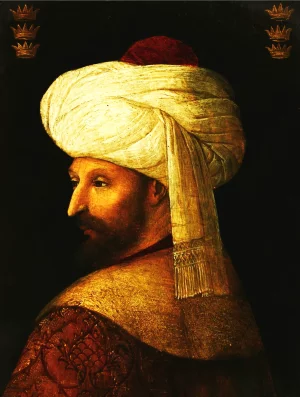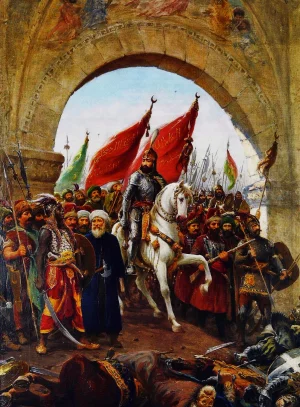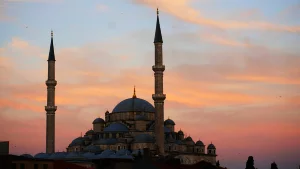Mehmed II
The Conqueror (1432-1481 AD)
-
QUICK FACTS
- NAME: Mehmed II, Fatih Sultan Mehmet, Mehmed the Conqueror
- OCCUPATION: Sultan, Ottoman Empire
- BIRTH: 30 March 1432, Edirne, Turkey
- DEATH: 3 May 1481 (age 49), near Istanbul, Turkey
- KNOWN FOR:
Capturing Constantinople and extending the Ottoman Empire into the Balkans.
Mehmed II, also known as Mehmed the Conqueror, was an Ottoman Sultan who ruled during the 15th Century. He is known for massively expanding the Ottoman Empire, as well as reinvigorating the city of Constantinople and his work in centralising the Ottoman government.
Historical Background

Sultan Mehmed II The Conqueror by a follower of Gentile Bellini 16th Century / Wikipedia
Mehmed was born in the capital of the Ottoman state, Adrianople (now Erdine in Turkey) in March 1432, to Sultan Murad II and his fourth wife Hüma Valide Hatun. As was traditional for Ottoman rulers, Mehmed was sent to Amasya in northern Turkey at the age of 11 to gain experience of governing. He was accompanied by a variety of Muslim teachers, who greatly reinforced his Islamic faith and shaped his outlook on life more generally.
When Mehmed was 12, he was granted rulership of Anatolia (now Turkey) by his father, who sought retirement in the southwest of the country. Soon after, Mehmed was forced to summon his father from retirement when the Hungarian military figure John Hunyadi attempted to invade Anatolia, thus violating the Peace of Szeged, a military treaty that his father, Murad, had signed with the Hungarian King Vladislaus. Murad subsequently returned to the throne of Anatolia and led the Ottoman army to defeat John Hunyadi at the Battle of Varna in 1444.
As a result of his Islamic teachings, Mehmed felt it was his Muslim duty to overthrow Byzantine rule in Constantinople (now Istanbul), the Roman Empire’s seat of power, and so when he reascended the throne in 1451 he began strengthening the Ottoman navy in preparation.
- Mehmed II
Conquests

Mehmed II entering Constantinople, painting by Fausto Zonaro (1854–1929) / Wikipedia
Mehmed began the siege of Constantinople in April 1453, with an army of between 80.000 and 200.000, and extensive artillery and naval forces, enabling the Ottomans to surround the city by land and by sea. Following a 57-day-long siege, the city fell to the Ottomans in late May, whereby Mehmed moved the Ottoman capital from Adrianople to Constantinople. He also claimed the title of caesar of the Roman Empire, however, this was not recognised by the Catholic Church and the majority of Western Europe. Once the city was under Ottoman rule, the Sultan focused on rebuilding its defences, repopulating it with diverse inhabitants, and establishing mosques and universities which transformed Constantinople into a thriving hub of culture. Mehmed went on to absorb the final two lasting regions of Byzantine rule, the Despotate of Morea in southern Greece and the Empire of Trezibond in northeastern Anatolia, into the Ottoman Empire in 1460 and 1461 respectively.
Mehmed next looked towards Serbia. The country had been a vassal state of the Ottoman Empire since the late 1300s. However, Serbia’s recent alliance with Hungary, and the fact that one of Mehmed’s wives was Serbian princess Mara Branković, led the Sultan to feel that he had a right to the country, and the Ottomans advanced on Serbia in 1454. Mehmed returned to Adrianople after the unsuccessful Siege of Belgrade against John Hunyadi in July 1456. However, by 1458 the 79-year-old Serbian ruler, Đurađ Branković had died, and turmoil amongst his widow and heirs enabled the Ottomans to take over Serbian land. As a reaction to continuing chaos, in June 1459 Mehmed sent his army to capture the city of Smederevo, ending that particular period of Serbian rule.
In the same year, following an unpaid tribute to the Ottomans by the ruler of Wallachia (now an area of Romania), Vlad III Dracula, violent fighting ensued between the two. Ultimately, Vlad III’s allies turned on him, forcing him to flee to the mountains and allowing Mehmed’s forces to capture Târgovişte, the capital of Wallachia. Mehmed instated Vlad’s younger brother, Radu, as ruler in 1462. Similarly, in 1463, after Bosnian leader Stephen Tomašević disputed a tribute due to the Ottomans, the Sultan invaded Bosnia, quickly captured it and executed Tomašević.
In continuation of the empire’s expansion, between 1463 and 1479, the Ottomans under Mehmed II were engaged in war with the Republic of Venice. The Ottomans rapidly expanded their navy in order to combat the Venetians in the Aegean Sea, and ultimately ended up gaining several areas of land in Greece and Albania that had been under Venetian rule for centuries. The war ended with the signing of the Treaty of Constantinople in 1479 when the Ottomans reached the outskirts of Venice, and led to the considerable weakening of Venice’s position as a military and trading power due to the expense and the loss of land incurred by the Venetians. In the meantime, the Ottomans had conquered several Anatolian principalities and gained significant control over rulers of the Crimea by 1476.
- Mehmed II
Death

Fatih Mosque, Istanbul / Pixabay
In 1480, an Ottoman army also attempted to invade Italy, however, the death of the Sultan led to their retreat. Having marched with the army, Mehmed had fallen ill at Maltepe, and died aged 49 on the 3rd May 1481. There is some suggestion that the Sultan was poisoned by his eldest son (and successor), Bayezid. His death was met by rejoicing across Europe and Asia Minor due to his relentless and ruthless expansion of the Ottoman Empire, and he was buried in the Fatih Mosque in Constantinople.










